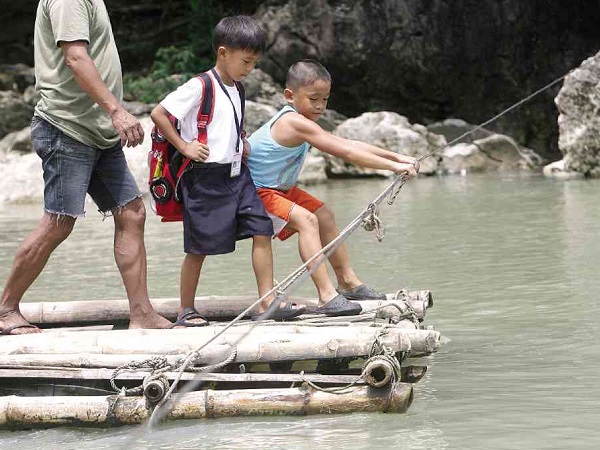
THERE are three ways for schoolchildren to cross this river in San Miguel, Bulacan. First, take a 5-kilometer winding hike to reach the other side or tiptoe on steel cable serving as a very narrow bridge for people. The third option is to ride a makeshift raft, as these boys are doing. MARIANNE BERMUDEZ
SAN MIGUEL, Bulacan—The Department of Public Works and Highways (DPWH) will build a hanging bridge in place of steel cables being used by schoolchildren to cross the Madlum River here, even though the project stands to benefit only four families living in Barangay Sibul.
The residents said their area was accessible by a road at the foot of a mountain in Sitio Madlum but they preferred to cross the river when the water level was low and use the steel cables when the river was swollen so they could cut their travel time.
Carlito Carpio, 60, a resident of Sitio Madlum, said he and other members of a people’s organization in the Biak na Bato National Park here installed the steel cables in 2000 so they don’t have to walk 5 kilometers to reach the opposite riverbank.
During good weather, residents pay P5 for a raft ride across the river, he said.
Carpio said the steel cables also brought in occasional income for residents, as tourists visiting the Biak na Bato National Park pay P50 each to cross and experience a different adventure.
Residents also installed a zipline near the steel cables and charged tourists P50 to P100.
Ramiro Cruz, head of the DPWH second engineering district office in Bulacan, said his office has completed the program of work for the project following an order by Antonio Molano, DPWH Central Luzon director.
Cruz said the hanging bridge is 36.5 meters long and 1.83 meters wide. The DPWH, he said, will need P3.5 million to build it.
Carpio said the steel cables helped people cross the river and buy food and other household items especially during heavy rains.
“We used to get stuck in our houses because we could not cross the river to buy rice whenever the river swelled. So we installed the steel cables to help us cross the river,” he said.
He said seven children belonging to four families living in the area use the steel cables to go to school.
“We use the steel cables as alternative if water is raging and the river is swelling,” he said.
Lito Reyes, another Madlum resident, said no accident had been recorded in the steel cables.
If a person slips while crossing the steel cables, he or she would fall into the river some 20 feet below. Residents said Madlum River is between 9 and 12 feet deep.